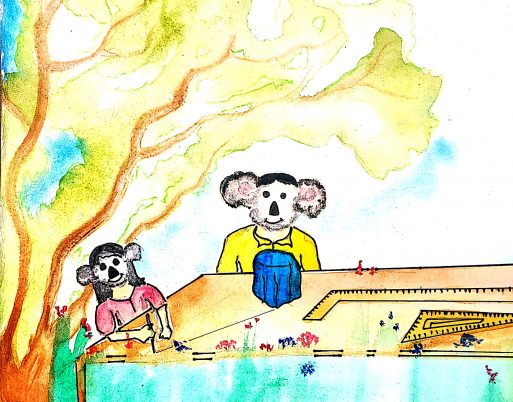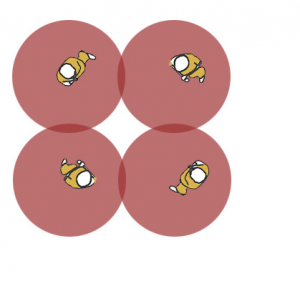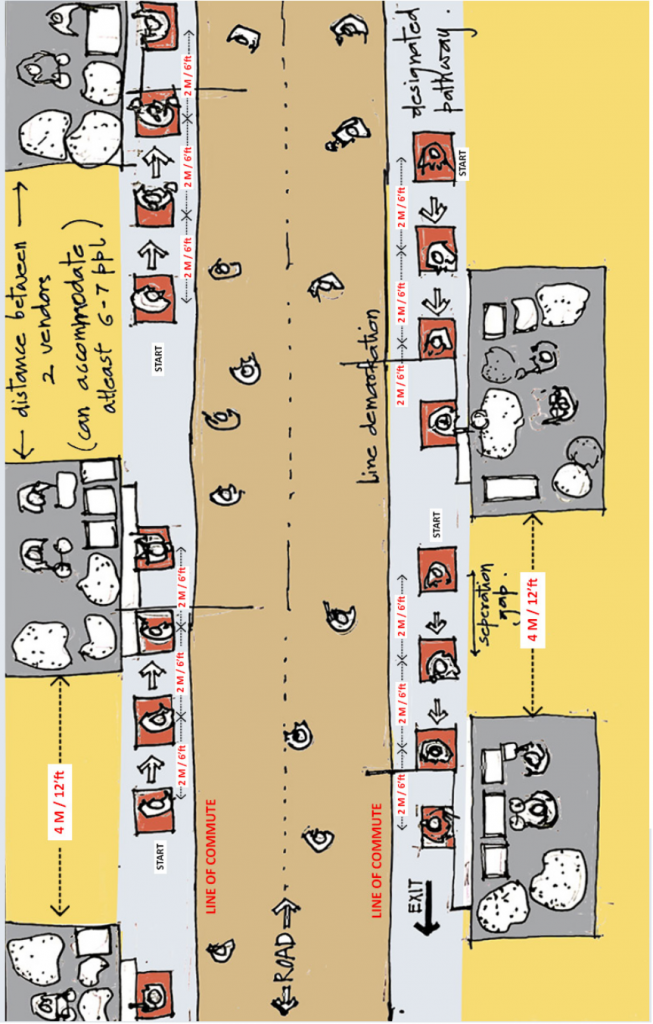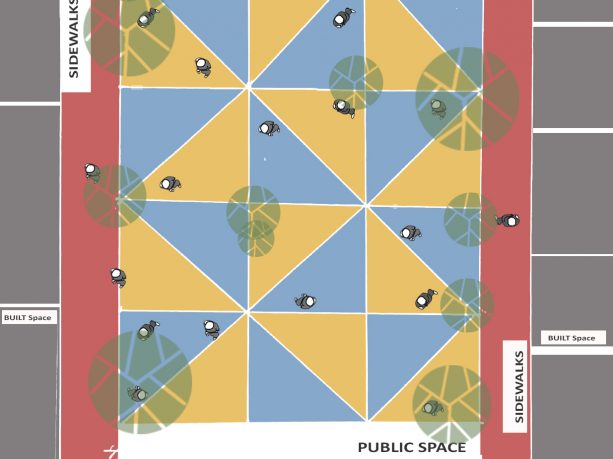Quarantining time “art of designing” piece by a group of Urban Designers, Architects, Ass. professors at DIT University,Dehradun, India

This beautiful piece of encouraging “Social distancing planning” is submitted by a team of Architects and Urban Designers Charles Porwal and Poonam Katre, presently both of them are involved in teaching and research in DIT University,Dehradun as an assistant professor.
This fascinating (social awareness for social distancing planning) during Covid19, the worst global pandemic is submitted by Ar. Charles & Ar. Poonam. It is a deeply moving piece of (ART OF DIY SOCIAL DISTANCING TOOLKIT FOR EVERYONE) at the time of quarantining work that we feel fortunate to put it in our featured wall. Thank you, Charles & Poonam for your valuable contribution. We think it will surely comfort millions particularly millennials at the time of deadly covid 19 pandemic and back our mental health awareness campaign!
This is part of an entry for the government competition held in “my gov” website for social awareness for social distancing. Its a graphical representation done for the general public with some ideas for government for maintaining the public space during lock down and observational period.
Cities are in total lockdown with empty Street, cafes, restaurants, mall, schools and institutions. Our streets are usually the hearts of public interactions for the city and the point of contact for various kind of social connections for the citizens. All of them are on pause now! When will it come to end and how? Is 21 days good enough? What changes it will bring? Don’t we really need to rethink how we were looking at our cities? All of these questions need to be answered. If not entirely, then at least need to be explored.
Does this pandemic highlight the great need for restructuring of public guidelines and initiation of the dialogue for our cities?
As we are battling against global crises of public health, the question of how we humans will response and learn from the condition will determine the future our city. Covid-19 has already had unaccountable effects on the lives of so many. This crises will force us to reexamine and question many things for our future.
But today the only solution to stem the spread of virus is SOCIAL DISTANCING-to keep people apart. We as an urban designers who are trying to learn how to make our public spaces work to create harmonious social gatherings, are now unfolding all our knowledge and moving in reverse direction to combat this crises.
Human being have always tried to programed themselves in crises and have come together to fight for the better tomorrow. In Covid 19 solution, human behavioral responses will put a great impact in dealing with the current situation. The best way to deal this situation is to channelize the human behavior in the environment by creating the Guidelines to be practiced in social distancing times.
This guideline is made by taking inspiration from citizen practicing social distancing measures with their own ‘make-a-do’ way, but we observed that only few of them have awareness about it. The concept of social distancing needs to reach every other citizen who will head out in this lockdown period for providing or getting essential services. India being majorly dependent up on informal sector, the highest need of practicing social distancing guideline lies there.
We aim to provide a graphical, easy to understand DIY (DO it Yourself) social distancing guidelines to every citizen of India.
Did you feel, Our earth have got clean sky, river, road, clean water, clean air to breath?
We actually experienced the similar environment as we live in outskirts of Dehradun in Mussorie Road in the midst of nature. It is usually very pleasant and calm throughout the year

2M / 6’
An Visual Guide to Social Distancing
for essential Businesses
Cities are in total lockdown with empty Street, cafes, restaurants, mall, schools and institutions. Our streets are usually the hearts of public interactions for the city and the point of contact for various kind of social connections for the citizens. All of them are on pause now! When will it come to end and how? Is 21 days good enough? What changes it will bring? Don’t we really need to rethink how we were looking at our cities? All of these questions need to be answered. If not entirely, then at least need to be explored.
Does this pandemic highlight the great need for restructuring of public guidelines and initiation of the dialogue for our cities?
As we are battling against global crises of public health, the question of how we humans will response and learn from the condition will determine the future our city. Covid-19 has already had unaccountable effects on the lives of so many. This crises will force us to reexamine and question many things for our future.
But today the only solution to stem the spread of virus is SOCIAL DISTANCING-to keep people apart. We as an urban designers who are trying to learn how to make our public spaces work to create harmonious social gatherings, are now unfolding all our knowledge and moving in reverse direction to combat this crises.
Human being have always tried to programed themselves in crises and have come together to fight for the better tomorrow. In Covid 19 solution, human behavioral responses will put a great impact in dealing with the current situation. The best way to deal this situation is to channelize the human behavior in the environment by creating the Guidelines to be practiced in social distancing times.
This guideline is made by taking inspiration from citizen practicing social distancing measures with their own ‘make-a-do’ way, but we observed that only few of them have awareness about it. The concept of social distancing needs to reach every other citizen who will head out in this lockdown period for providing or getting essential services. India being majorly dependent up on informal sector, the highest need of practicing social distancing guideline lies there.
We aim to provide a graphical, easy to understand DIY (DO it Yourself) social distancing guidelines to every citizen of India.
Cities around the world are achieving social distancing through two kind of approaches. Firstly, a ‘Restrictive approach’, where there is a restriction on the most of the non-essential business and activities resulting into their close down and engagement of the people in any public socializing activities.
And the second one is ‘Distributive approach’ where most of the essential activities and businesses are distributed and shift to large open areas of the city such as gardens, grounds, maidans, highways, seafronts and neighborhood roads to meet the safer public requirements. The shifting is mainly done for the smooth vending activities who providing daily needs to the public. By taking a distributive approach and spreading these essential business, hold a potential to give us leverage over its operating controls. In combination with the guidelines, these activities can function in much more structured manner.

Demostration of the scenario in plan for large open areas

On Street Vending

Detail demostration of the scenario
This toolkit is created by taking inspiration from social distancing practices happening around the world.These were just few examples, more guidelines can be made for many other social interactions shown below.

On Ground Vending
On Cart Vending

Shop, medical stores, grocery

ATMs
This guidance is for everyone who are going outside in next 21 days to carryout essential businesses and those who will be providing this services. It advises on social distancing manners and measures we should all be taking to reduce social interaction during any kind of ‘dewan-ghewan’ to reduce the transmission of coronavirus (COVID-19).

Illustration showing the conceptual idea of the pattern in public space used for social distancing.
The concept of Collectivism and Individualism is an idea of utilizing the public space during social distancing and normal times. The Grid pattern of 3-4 metres in public space also generated the visual charachter along with conscious distancing during panedemic times.
FEATURES
- Restrict the distances visually between the two or more people at the times of panedemic due to graphics.
- Generating the sufficient space in one pattern for an individual or group of 2-3 known people.
- Providing a visual experience to the users.
- During panedemic times, the pattern can generated the demarcaiton for informal vendors.
- During normal times, it provide a interactive and playful space to the public due to colorful patterns.
MODE OF IMPLEMENTATION Permanent – Tiling through different materials. Temporary – Coloring and Line demarcation.

Illustration showing the character of the public space
CONCEPT B FOR LARGE PUBLIC SPACE

Illustration showing the interaction during social distancing
The concept of generating physical social distancing through transparent barrier with maintaining the audio and visual access. The idea talks about the interactive vertical planes in the public space to give a interesting character and identity to the public space which can be used for movement during the social distancing times and can also acts as a rememberance to the people who worked for covid-19 panedemic.
